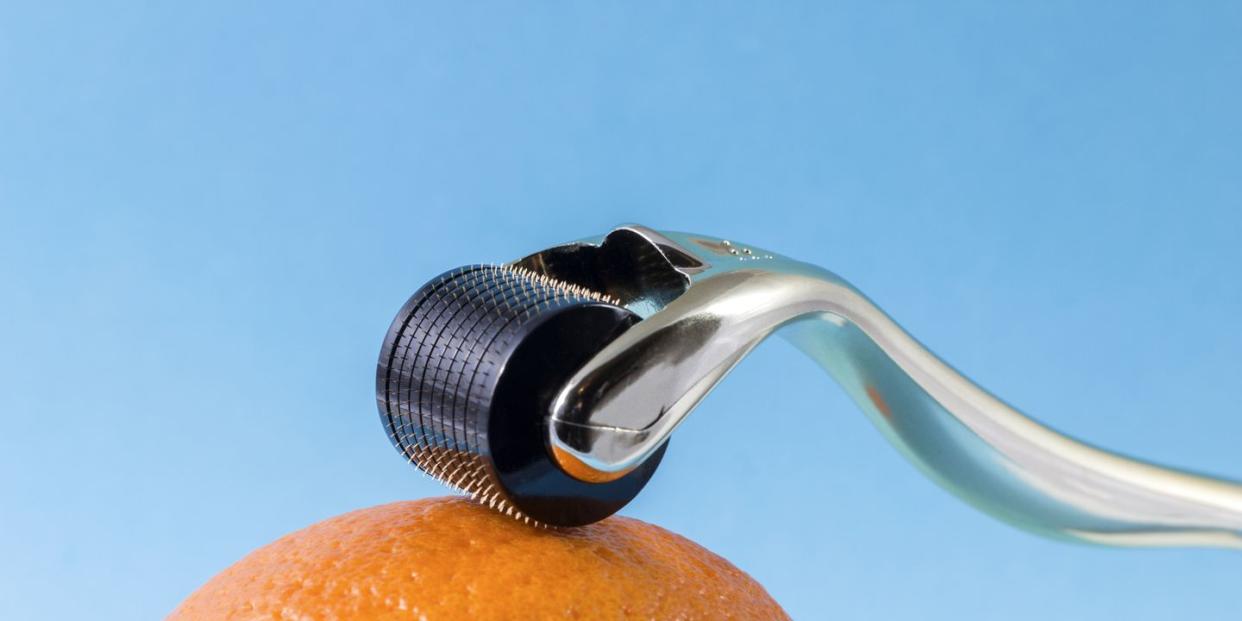Dermatologists Explain the Truth About Microneedling

Would you roll needles all over your face for smoother skin? That’s the promise of the trendy treatment microneedling, with compelling before-and-after photos (and some horror stories) flooding the internet.
In the microneedling procedure, a dermaroller wand studded with tiny needles is run over skin to even out its texture, including wrinkles and scarring, says Mona Gohara, M.D., associate clinical professor of dermatology at Yale School of Medicine. There are even claims that it can help reduce stubborn stretch marks.
But is microneedling safe and does it work? Good Housekeeping Institute Beauty Lab skin scientists and dermatologist experts weigh in on everything you need to know about microneedling, and if you should ever do it at home.
What does microneedling do for your skin?
The treatment (which can be performed by a dermatologist or aesthetician in-office or done at home) involves rolling a roller with tiny needles along the skin. The microneedling pen's needles produce micropunctures in skin that can enhance the absorption of skincare products and cause an increase in collagen production, which can minimize fine lines and scarring from causes like acne over time, among other benefits, Dr. Gohara explains.
A post shared by Dra Ana Carolina Munhoz (@dra.anacarolinamunhoz) on Jul 26, 2019 at 1:01pm PDT
Is microneedling effective?
Yes: When done by a professional dermatologist, "microneedling can be effective at boosting the penetration of topical skincare and plumping skin, and there is data to show its efficacy in reducing fine lines and wrinkles," Dr. Gohara says. "And a study found microneedling may be as helpful lasers and other resurfacing devices for reducing acne scars."
It's also a great option for minimizing stretch marks, experts say: "In my opinion, microneedling is the single best treatment for stretch mark reduction," says Manish Shah, M.D., a plastic surgeon based in Colorado. "Microneedling improves the color and appearance of stretch marks by creating tiny pinhole injuries in the stretch mark itself. The skin responds by making new collagen, filling in the broken dermal layer. As the dermal layer expands, the color fades because the skin thickens and the tiny blood vessels that give early stretch marks their pink/purple color retreat."
A post shared by AktasAudrey (@aktasaudrey) on Jul 26, 2019 at 1:10am PDT
Does microneedling hurt?
Done in the hands of a professional dermatologist, there should be zero to minimal pain, side effects, or down time from microneedling treatments, though some may experience minor skin irritation immediately after. If done improperly at home, microneedling has the potential to cause scratching or burning pain and irritation, redness and inflammation, marks, and even bleeding and scarring on skin. Your dermatologist can advise you on the proper after-care procedure for your skin to minimize irritation and facilitate best results.
How long does it take to see results from microneedling?
"Response to treatment may vary, but some may need four to six sessions over several months to obtain the desired results, while others may be happy after one to two," Dr. Gohara explains. "But maintenance treatments may be necessary to keep the progress up and prevent further damage." In between, your dermatologist can advise you on whether you can continue your regular skincare regimen, including other types of exfoliating and skin resurfacing products while receiving microneedling treatments.
Depending on the skin issue, the severity of it, your age and skin condition, and whether the treatment is done by a professional, the results can range from subtle improvement (i.e. softening the look of lines and marks) to a dramatic change (erasing of wrinkles and acne scars), as seen here.
A post shared by BodySculptingSpa (@body_sculpting_spa) on Jul 25, 2019 at 1:32pm PDT
How much does microneedling cost?
Depending on the location and practitioner, professional microneedling by a dermatologist or aesthetician can cost anywhere between $100 to upward of $500+ per treatment, with a series of four to six treatments often required to see results, the number of which can vary based on skin issue and condition.
Is microneedling at home safe?
Recently, the FDA issued an alert to manufacturers about potential regulation of microneeding pens as medical devices. It may not be worth the risk to DIY: In a GH Beauty Lab study, 25 women used a popular at-home dermaroller system. After four weeks, there was no difference in the appearance of skin on the side where the dermaroller was used, according to digital imaging with the Visia Complexion Analyzer device, or in the improvement of firmness, per measurements with the Lab’s Cutometer machine. Testers also complained that the tool hurt during use, felt sharp, and scraped their skin. One developed a rash from use and two did not complete the study due to skin irritation.
If you want to try microneedling, the GH Beauty Lab and our experts recommend going pro for optimal results and less risk: “This procedure can work wonders if used correctly, but microneedling devices are best used by a trained professional to mitigate the risk of overuse and permanent damage,” Dr. Gohara advises. Getting the treatment at a dermatologist's office will also ensure the needles are sterile, which is crucial for preventing skin damage and infection. “Consult a dermatologist to see if it’s for you and come up with the best treatment plan," she says.
You Might Also Like

